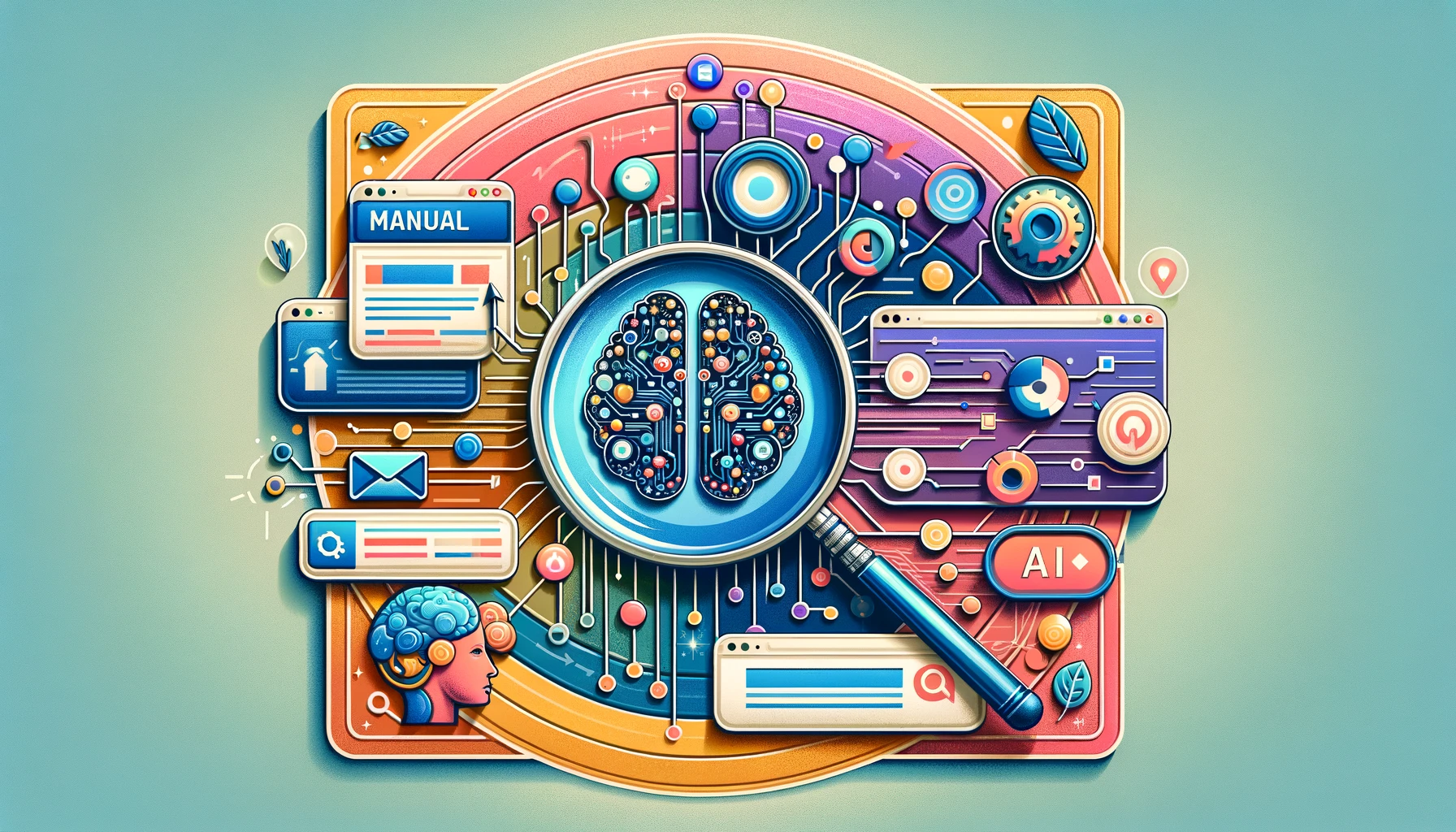

In the dynamic landscape of digital advertising, Dynamic Keyword Insertion (DKI) has long stood as a cornerstone technique, enabling advertisers to tailor their ad copy in real-time based on user search queries. However, as the digital marketing ecosystem evolves, the need for alternative strategies becomes increasingly apparent. These alternatives not only offer a breadth of creative and strategic options but also cater to the nuanced demands of today's diverse online audiences.
DKI, while effective in enhancing ad relevance and click-through rates, is not without its limitations. Issues such as inappropriate keyword matches and a lack of personalization beyond the search term can lead to a disconnect with the audience. Moreover, the growing sophistication of ad blockers and shifting user expectations towards more personalized and contextually relevant content necessitate a broader toolkit for advertisers.
The integration of NLP (Natural Language Processing), machine learning, and predictive analytics into advertising strategies represents a significant shift towards more intelligent and automated content creation. These technologies enable a deeper understanding of user sentiment, intent, and preferences, allowing for highly customized ad experiences.
As the advertising world continues to evolve, embracing alternatives to Dynamic Keyword Insertion becomes essential. By leveraging manual strategies, contextual insights, and the power of AI, marketers can create more meaningful and effective ad campaigns that resonate with their audience on a deeper level.
In the realm of digital advertising, the quest for the most effective method to capture audience attention is never-ending. Dynamic Keyword Insertion (DKI) has been a popular technique, but its limitations have led advertisers to seek alternatives that offer greater control and customization. One such alternative is Manual Keyword Insertion (MKI), a strategy that, despite its simplicity, offers a tailored approach to ad customization and audience targeting. This chapter delves into the nuances of Manual Keyword Insertion, highlighting its benefits and challenges.
Manual Keyword Insertion is precisely what its name suggests: the manual addition of keywords into ad copy by advertisers, as opposed to the automated insertion of keywords based on user queries. This method allows for a high degree of precision and personalization, ensuring that the ad content is directly aligned with the advertiser's intended message and target audience.
To maximize the effectiveness of Manual Keyword Insertion, advertisers should focus on deep audience research, continuously test and refine their ad copy, and leverage data-driven insights to inform their strategies. Combining MKI with other advertising techniques, such as contextual targeting and AI-driven content personalization, can also enhance campaign performance.
Manual Keyword Insertion offers a viable alternative to DKI, providing advertisers with the control needed to create highly customized and effective ad campaigns. By carefully weighing its pros and cons, marketers can integrate MKI into their advertising toolkit to achieve better engagement and conversion rates.

In the rapidly evolving landscape of digital advertising, the quest for precision and relevance in ad targeting has led to the exploration of sophisticated alternatives to Dynamic Keyword Insertion (DKI). Among these, Contextual Targeting emerges as a powerful strategy, distinguished by its unique approach to aligning ad content with the thematic essence of websites. This chapter unfolds the intricacies of Contextual Targeting, demonstrating its pivotal role in enhancing ad relevance and effectiveness without relying on direct keyword matches.
Contextual Targeting stands as a refined method that matches ads to website content based on the theme and context, rather than specific keywords entered by users in search queries. This distinction marks a strategic departure from DKI, offering a nuanced approach to ad placement that ensures relevance and engagement.
For advertisers seeking to refine their strategies beyond DKI, contextual targeting offers a compelling avenue. By understanding and leveraging the content environment, advertisers can create more meaningful and engaging ad experiences. Embracing advanced technologies and tools that facilitate semantic ad customization and content optimization further enhances the precision and impact of contextual targeting efforts.
Contextual Targeting not only represents an alternative to DKI but also signifies a shift towards more thoughtful and audience-respectful advertising practices. As digital landscapes continue to evolve, the importance of context, content relevance, and user experience cannot be overstated.

In the quest for enhanced relevance and personalization within digital advertising, the spotlight has increasingly fallen on AI-Driven Content Personalization. This innovative approach marks a significant evolution from Dynamic Keyword Insertion (DKI), leveraging cutting-edge technologies such as Natural Language Generation (NLG) and Machine Learning (ML) to dynamically tailor ad content to individual users. This chapter explores the transformative potential of AI-Driven Content Personalization, detailing how it redefines the ad customization landscape.
AI-Driven Content Personalization represents the convergence of technology and marketing, offering an advanced alternative to the limitations of DKI. By analyzing vast amounts of data on user behavior, preferences, and interactions, AI technologies can generate ad content that is not only relevant but also deeply resonant with the target audience.
The shift towards AI-Driven Content Personalization is not just about keeping pace with technological advancements but about embracing a future where advertising is more intuitive, responsive, and effective. By integrating technologies like NLG and ML, advertisers can craft campaigns that speak directly to the individual, fostering a deeper connection and driving superior outcomes. AI-Driven Content Personalization stands at the forefront of advertising innovation, offering a path beyond the constraints of DKI. As we continue to navigate the complexities of digital marketing, the adoption of AI technologies presents an opportunity to redefine engagement and success in advertising.
In the ever-evolving realm of digital advertising, the pursuit of more sophisticated and effective strategies has led to the development of Semantic Ad Customization and Behavioral Targeting. These alternatives to Dynamic Keyword Insertion (DKI) offer a nuanced approach to ad creation and placement, focusing on the semantic understanding of content and the analysis of user behavior to deliver highly personalized ad experiences. This chapter explores the intricacies of these methods, highlighting their potential to revolutionize advertising efforts.
Semantic Ad Customization transcends the traditional keyword-based approach, delving into the deeper meaning and context of web content to align ads with related themes and concepts. This strategy leverages Natural Language Processing (NLP) and semantic analysis technologies to understand the essence of content, ensuring ads are not just relevant but also resonant with the audience's current engagement.
Behavioral Targeting represents a shift towards a more personalized advertising strategy, utilizing data on user behavior, preferences, and interaction history to tailor ads. This method applies Machine Learning (ML) and data analytics to craft ad experiences that are not only relevant but also predictive of user needs and future actions.
The fusion of Semantic Ad Customization and Behavioral Targeting offers a comprehensive strategy for advertisers seeking to transcend the limitations of DKI. By understanding both the content users engage with and their behavior across the digital ecosystem, advertisers can create highly personalized, relevant, and effective ad campaigns.
Semantic Ad Customization and Behavioral Targeting not only serve as alternatives to DKI but also represent the future of digital advertising. By harnessing the power of semantic understanding and behavioral analytics, advertisers can achieve a level of personalization and relevance that resonates deeply with their audience.

In the digital age, where advertising efficiency and effectiveness are paramount, advertisers are constantly seeking innovative strategies to optimize their campaigns. Alternatives to Dynamic Keyword Insertion (DKI) have emerged, with Programmatic Advertising and Predictive Analytics leading the charge towards more automated, targeted, and intelligent advertising solutions. This chapter delves into how these technologies redefine ad placement and performance forecasting, providing advertisers with a strategic edge in the competitive digital marketplace.
Programmatic Advertising Solutions have revolutionized ad buying and placement, utilizing advanced algorithms to automate the process of targeting specific audiences across various digital platforms. This approach not only streamlines the advertising process but also ensures that ads are displayed to the most relevant audiences, maximizing impact and efficiency.
Predictive Analytics takes data analysis to the next level by using historical and real-time data to forecast future ad performance and user engagement. This approach enables advertisers to anticipate trends, user behavior, and potential engagement outcomes, allowing for strategic campaign adjustments before deployment.
The combination of Programmatic Advertising and Predictive Analytics offers a powerful toolkit for advertisers aiming to transcend traditional methods like DKI. This integrated approach not only automates ad placement but also ensures that each ad is optimized for performance, based on predictive insights into user engagement and behavior.
Programmatic Advertising and Predictive Analytics represent a significant advancement in digital advertising, offering a blend of automation, efficiency, and strategic foresight. As we move forward, these technologies will continue to shape the future of advertising, making it more responsive, targeted, and effective.

As we conclude our exploration into the effective alternatives to Dynamic Keyword Insertion (DKI), it's clear that the landscape of digital advertising is both vast and nuanced. The evolution of ad customization techniques has opened up a world of possibilities for marketers seeking to enhance their advertising efforts and connect more meaningfully with their target audiences. This chapter summarizes these alternatives and underscores the significance of adopting a multifaceted approach to ad customization.
The journey through the realms of Manual Keyword Insertion, Contextual Targeting, AI-Driven Content Personalization, Semantic Ad Customization, Behavioral Targeting, Programmatic Advertising, and Predictive Analytics has illuminated the diverse toolkit available to modern advertisers. Each method offers unique advantages:
The choice among these alternatives should be informed by a comprehensive understanding of campaign goals, the specific needs of target audiences, and the resources at your disposal. A successful advertising strategy may often involve a combination of these techniques, carefully selected and harmonized to achieve the desired impact.
The landscape of digital advertising continues to evolve, with emerging technologies and changing consumer behaviors presenting both challenges and opportunities. Marketers are encouraged to stay informed, experiment with new approaches, and always prioritize the relevance and personalization of their ad content. By doing so, they can ensure that their campaigns resonate deeply with their audience, driving engagement and achieving their marketing objectives.
Eager to revolutionize your advertising approach with these alternatives? Take the first step towards transforming your marketing strategy today.
Manual Keyword Insertion (MKI) offers more control and customization, allowing advertisers to precisely tailor ad messages to their audience. However, it requires more time and resources for setup and ongoing management compared to Dynamic Keyword Insertion (DKI), which automates keyword insertion based on user queries. MKI can be less efficient in large-scale campaigns but provides superior brand consistency and message alignment.
Yes, Contextual Targeting emerges as a privacy-friendly alternative by matching ads with web content themes rather than relying on user behavior tracking. This method respects user privacy, as it does not necessitate collecting personal data, making it an attractive option in the face of growing data privacy regulations and user concern. It ensures relevance without compromising individual privacy.
AI-Driven Content Personalization leverages machine learning and natural language generation to create ads that are highly relevant to individual users, based on their behaviors and preferences. This personalized approach significantly enhances user engagement, as ads are more likely to resonate on a personal level, compared to traditional methods that might not capture the nuanced interests of the audience.
While Behavioral Targeting offers precise personalization by analyzing user actions and preferences, it raises privacy concerns as it relies heavily on data collection and tracking. Additionally, there's the risk of creating a filter bubble, where users are only exposed to content and ads that align with their past behavior, potentially limiting the diversity of content and products they encounter.
Programmatic Advertising automates the buying and placement of ads across various channels, ensuring efficiency and reach. When combined with Predictive Analytics, which forecasts future trends and user behavior, advertisers can strategically plan their campaigns to optimize for performance. This synergy allows for real-time adjustments based on predictive insights, enhancing the relevance and effectiveness of ads, leading to improved ROI and user engagement.
